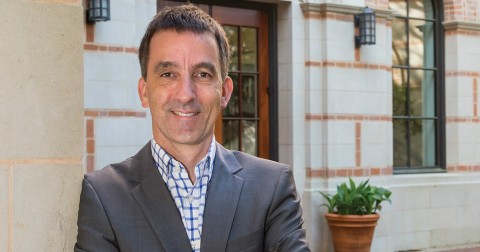Jesus the (Second Temple-era) Jew
“If we don’t understand the Judaism of Jesus’ time, how can we understand him and his message?”

A scholar of the texts of the Qumran community and early Judaism, Matthias Henze teaches at Rice University, where he is founding director of the program in Jewish studies. His books include Jewish Apocalypticism in Late First Century Israel and Mind the Gap: How the Jewish Writings between the Old and New Testament Help Us Understand Jesus.
You’ve focused on a period of biblical history that is sometimes referred to as “intertestamental,” since it covers the period after most of the Old Testament was written and before most of the New Testament was written. Scholars often use another term, “Second Temple Judaism,” to designate the Judaism that flourished in this period—after the rebuilding of the temple in 516 BCE until the destruction of the temple in 70 CE. How would you characterize Second Temple Judaism?
Read our latest issue or browse back issues.
A number of things occurred during these roughly 600 years that changed Israel forever. It may not be an overstatement to say that Jesus and the early Jesus movement would have been inconceivable without the dramatic changes and transformations that took place in Second Temple Judaism.
Six events stand out for me. First, the monarchy came to an end. During the Second Temple period, Israel was no longer ruled by kings, as it was during the First Temple period. At the same time, prophecy also ended, as many prophets were closely aligned with the monarchy.
Second, the second temple in Jerusalem never had the same significance as the first temple, and it certainly never enjoyed the same theological, unifying authority. To the contrary, more and more groups distanced themselves from the Jerusalem temple, most famously, perhaps, the group that left us the Dead Sea Scrolls: they preferred a life in the Judean desert in self-imposed exile.
Third, the Second Temple period saw the emergence of the Diaspora as a permanent reality in Judaism. In the Old Testament, the books of Esther and Daniel are set in the Diaspora.
Fourth, and perhaps the most defining attribute of Second Temple Judaism: its ever-increasing, internal divisions and the dramatic fragmentation of Judaism into smaller groups. The first-century CE historian Josephus tells us that there were three main groups: the Pharisees, the Sadducees, and the Essenes. We now know that there were many more than three groups. Initially, the followers of Jesus formed one such early Jewish group. It wasn’t until centuries later that Christianity clearly became a distinct religion.
Fifth, the word of God ceased to be exclusively oral and increasingly became a written text. The writing down of God’s message ultimately led to the emergence of the first biblical canons.
And sixth, the Second Temple period was a time of unprecedented intellectual creativity, theological exploration, and literary productivity. A wealth of new texts were written, only a few of which found their way into our Bibles.
The Jewish writings produced in the centuries just before Jesus—books like First Enoch or Jubilees—are little known by Christians. Does that matter?
If Christians want to understand Jesus and those who first wrote about him, we need to have at least a rudimentary knowledge of Jesus’ Judaism. If we don’t understand early Judaism, how can we understand Jesus and his message?
The main challenge here is that the Judaism of Jesus is not the religion in the Old Testament. In other words, the Old Testament cannot explain the Judaism of Jesus. The reason for this is chronological: the books of the Old Testament were written hundreds of years prior to the time of Jesus, they stem from a different era, and they reflect a different stage in the religion of Israel. It is a bit like wanting to explain the United States today by pointing to the US Constitution.
In order to learn about the Judaism of Jesus, we need to turn to Jewish texts that are closer in date to the time of Jesus. This is where texts such as First Enoch, Jubilees, and Fourth Ezra become invaluable: they help us fill in the chronological gap that exists between the Old and the New Testament and inform us about the Judaism of Jesus.
If you were to pick one of these texts to teach to a group of Christians, what would it be? Why?
I have often taught Fourth Ezra and Second Baruch, two closely related early Jewish apocalypses from the late first century CE, because they resemble in many ways the writing of St. Paul. The book of Jubilees includes some delightful reading of the book of Genesis.
Perhaps the richest early Jewish text is First Enoch, an apocalypse that tells the story of the fallen angels. It is a marvelous example of the early Jewish imagination: it includes retellings of biblical stories, visions of the heavenly throne room, depictions of the Messiah, fantastic journeys to the end of the world.
Can you cite an example from one of these works that illuminates part of the New Testament?
An example would be a section of Second Baruch on the resurrection of the dead in comparison with 1 Corinthians. In 1 Corinthians 15, Paul provides a detailed description of his view of the resurrection of the dead. Some Corinthians had called the resurrection into question, and so Paul feels compelled to explain why the belief in the resurrection is so central to the Christian faith. Without it, Paul argues, Christian hope would be in vain (1 Cor. 15:12–19). Paul predicts how the events of the end time will unfold (vv. 20–28). Next he turns to the question of the physical resurrection of the body. “But someone will ask, ‘How are the dead raised? With what kind of body do they come?’” (v. 35). Initially Paul doesn’t seem very sympathetic to the concern for the material integrity of the body and simply retorts, “Fool!” But then he goes on and answers the question. He emphasizes that the body of the resurrected will not look like the body we have right now but will be transformed. “It is sown a physical body, it is raised a spiritual body” (v. 44).
The longest description of the belief in the resurrection in early Jewish literature is found in 2 Baruch 49–52. Similar to Paul’s treatise, the passage in Second Baruch also begins with a question, only in this case it is Baruch who wants to know from God, “in what shape will those live who live in your day? . . . Will they indeed then take this form of the present . . . or will you perhaps change them who are in the world, as [you change] also the world itself?”
In answering, God walks Baruch through the resurrection step by step: initially, the dead will be resurrected into their old human body. Then they will be gradually transformed into light and splendor, then they can assume any shape or form they desire, until, at last, they will be “more excellent than the angels” (2 Bar. 51:12).
Paul and the author of Second Baruch were both Jewish authors of the late Second Temple period, and both were concerned about the process of resurrection, specifically, about the fate of the human body. Paul emphasizes the discontinuity—the present body isn’t anything like the body of the resurrected—whereas the author of Second Baruch describes a gradual transformation of the resurrected righteous, who begin with their earthly body and end up in some kind of angelic state that makes them even superior to the angels.
In terms of theology, the period from the fourth century BCE to the time of Jesus was extraordinarily creative, developing beliefs about individual resurrection, expectations of an apocalypse, and ideas of angels and demons. How do you account for this burst of theological reflection?
In the 1970s and 1980s, scholars debated rigorously how best to explain this burst of new ideas, theological reflections, and literary forms of expression. Some argued for outside influences, suggesting, for example, that the concept of dualism was imported from Zoroastrianism, and the new interest in cosmology was derived from Babylonian calculations. Others countered that there is no reason to look to the other civilizations of the ancient Near East to explain the changes.
Such debates can easily become politicized: scholars who do not particularly like the extrabiblical writings of the Second Temple period are prone to argue that the new ideas were derived from other civilizations and ultimately remain at odds with genuine Israelite thinking as we find it in the Old Testament, while those who find value in these texts are inclined to explain their emergence as the next step in the evolution of ancient Israelite thought and literature, a logical development in the religious imagination.
I’d stress that the rich literature of Second Temple Judaism both stands in continuity with the Old Testament and marks a real departure. Take the apocalypse, for example. As a literary genre, the apocalypse is a new phenomenon of the Second Temple period. And yet, apocalyptic thinking is deeply shaped by Israelite wisdom literature and biblical prophecy, from which it arose.
Some of these writings traditionally found a place in the Catholic Bible, where they are known as the Apocrypha. Why didn’t they make it into the Protestant Bible?
In a sense, the Apocrypha are part of the Protestant Bible. In his German translation of the Bible, Martin Luther created a third rubric of texts—besides the Old and the New Testament—and called it the Apocrypha, a term he borrowed from Jerome. Many English Bible translations today include this section, inserted in between the Old and the New Testament, titled the Apocrypha.
The categories commonly used to categorize ancient Israelites texts are tricky, and scholars are increasingly unhappy with them. The term Apocrypha, for example, is Greek and means “hidden.” It is deliberately pejorative, intended to diminish the theological significance of these texts and to put them in the shadow of the canonical texts. Today, scholars realize that we are much better served reading these documents on their own instead of seeing them as derivatives of, and ultimately inferior to, the canonical writings.
Is there evidence that Jesus was familiar with these texts?
No. We have no idea what Jesus read. In fact, there is little evidence that the authors of the New Testament were familiar with the Apocrypha or the Pseudepigrapha, for that matter. A famous exception is the Letter of Jude, whose author appears to have known traditions about the “fallen watchers” as we find them in First Enoch. But other than that, the evidence is thin.
It is always risky to postulate that a certain ancient author knew a certain text. It is much safer to say that an author appears to have been familiar with concepts or ideas that are also expressed in another ancient text that is roughly contemporary. In other words, my argument is not that the authors of the New Testament knew the same early Jewish texts that we are reading today. My point is that the rich library of Second Temple Judaism helps us understand Jesus’ Judaism, the Judaism that is assumed throughout the New Testament.
What do we know about how rabbinic Judaism—which was arising alongside Christianity—viewed or used these texts?
The rabbis who were active at the time of the destruction of Jerusalem in the year 70 CE had a formidable challenge on their hands: they needed to create a new form of Judaism in the absence of the temple—a permanent form of Judaism that would endure and could not be destroyed again.
With the exception of the Dead Sea Scrolls, almost all the manuscripts we have of early Jewish literature are Christian in origin. Jewish scribes showed little interest in preserving the extrabiblical writings. But the texts and ideas expressed in these texts are not entirely absent from the rabbinic corpus. Every so often, the rabbis referred to the apocryphal book of Ben Sira, for example. They knew of the apocalyptic imagination that was widespread toward the end of the Second Temple period, and in a few places they refer to the messianic expectations, even if they were not fond of such end time speculations. They preferred to focus on the Torah and not to dwell on apocalyptic thoughts about an impermanent, transient world.
For Christians, John the Baptist is the figure who gathers together some themes of Second Temple Judaism. How might we understand him as a figure of the intertestamental period?
Judaism of the Second Temple period was characterized by fragmentation: it consisted of many groups that held different worldviews. John the Baptist belonged to the apocalyptic wing of early Judaism, in close proximity to, though not identical with, the people of Qumran who left us the Dead Sea Scrolls.
Even within the apocalyptic wing there were many Jewish groups with different beliefs and practices. They were united in thinking that the world as we know it was about to come to an end, and that the end of time was about to unfold according to a plan predetermined by God. One such episode in the eschatological scenario was the arrival of the Messiah. Several early Jewish texts mention a messianic figure who will come at the end of days. With his apocalyptic message and his proclamation of the arrival of the Messiah, John the Baptist fits squarely within Jewish apocalypticism.
A version of this article appears in the print edition under the title “Inside Jesus’ Judaism.”






